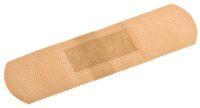Applying dressings to wounds is a common practice throughout the world, both in and out of hospitals. At times, removing such dressings can be more painful than the wound itself.1 Research on dressing removal has often focused on expensive new products2 and, although speed of dressing removal has been controlled for in some studies2 (implying that speed is a factor), we are not aware of any research directed specifically at different speeds of dressing removal. There are Internet sites addressing how to reduce the pain associated with removal of certain brands of dressings, such as Band-Aid (Johnson & Johnson, New Brunswick, NJ, USA) (eg, http://www.wikihow.com/Remove-a-Band-Aid); however, there is no consensus on the issue of speed.

The pain of dressing removal is thought to be related to the mechanical stripping of the stratum corneum from the underlying epidermal and dermal cells.3 However, the perception of pain is complex — it is a multifactorial experience influenced by culture, previous pain events, beliefs, mood and ability to cope.4
The study protocol was approved by the Townsville Health Service District Institutional Ethics Committee and conforms to the provisions of the Declaration of Helsinki.5 There was no manufacturer involvement in the study.
Our results show that FBAR was less painful than SBAR. This is consistent with the preconceptions of most of our sample. A high body hair score was, not surprisingly, associated with higher pain scores, and it seemed that preconceptions also had an appreciable effect. Several other aspects of our data may require further investigation. The pain experience is a complex and incompletely understood process that incorporates many aspects of patients’ social and cultural beliefs, as well as previous experiences.4 Our observation that preconceptions were associated with pain scores should not therefore be surprising.
Our study had other limitations. These included the inability to blind the participants (in terms of which removal technique and which side of the body would be tested first) and preconceived ideas regarding the technique that would be more painful, both of which may have biased our results. However, the use of randomisation and a crossover design should have minimised this inherent bias. In addition, scoring pain is an imprecise science and there is no perfect pain assessment tool. The verbal numeric pain scale is a commonly used pain assessment tool and has been validated for use in emergency settings.6 It is possible that it may be less reliable and reproducible at the lower ends of the pain scale.
- Jeremy S Furyk1,2
- Carl J O’Kane1,2
- Peter J Aitken1,2,3,4
- Colin J Banks1,2
- David A Kault5
- 1 Department of Emergency Medicine, Townsville Hospital, Townsville, QLD.
- 2 Townsville Institute of Research in Emergency Departments (TIRED), Townsville, QLD.
- 3 Anton Breinl Centre, James Cook University, Townsville, QLD.
- 4 Queensland Emergency Medicine Research Foundation, Brisbane, QLD.
- 5 School of Engineering and Physical Sciences, James Cook University, Townsville, QLD.
None identified.
- 1. Woo KY, Harding K, Price P, Sibbald G. Minimising wound-related pain at dressing change: evidence-informed practice. Int Wound J 2008; 5: 144-157.
- 2. Dykes P, Heggie R. The link between the peel force of adhesive dressings and subjective discomfort in volunteer subjects. J Wound Care 2003; 12: 260-262.
- 3. Dykes P, Heggie R, Hill S. Effects of adhesive dressings on the stratum corneum of the skin. J Wound Care 2001; 10: 7-10.
- 4. Australian and New Zealand College of Anaesthetists and Faculty of Pain Medicine. Acute pain management: scientific evidence (second edition). Melbourne: ANZCA, 2005. http://www.nhmrc.gov.au/_files_nhmrc/file/publications/synopses/cp104.pdf (accessed Aug 2009).
- 5. World Medical Association Declaration of Helsinki — Ethical Principles for Medical Research Involving Human Subjects. http://www.wma.net/en/30publications/10policies/b3/index.html (accessed Sep 2008).
- 6. Holdgate A, Asha S, Craig J, Thompson J. Comparison of a verbal numeric rating scale with the visual analogue scale for the measurement of acute pain. Emerg Med (Fremantle) 2003; 15: 441-446.





Abstract
Objective: To determine whether slow or fast bandaid removal is less painful.
Design, setting and participants: A prospective, randomised, crossover trial was carried out at James Cook University, Townsville. Participants were healthy volunteers from Years 2 and 3 of the James Cook University medical school program.
Interventions: Medium-sized bandaids were applied bilaterally in three standard body locations and removed using slow and fast techniques.
Main outcome measures: Pain scores were assessed using an 11-point verbal numeric pain scale.
Results: 65 participants were included in the study. The overall mean pain score for fast bandaid removal was 0.92 and for slow bandaid removal was 1.58. This represents a highly significant difference of 0.66 (P < 0.001).
Conclusion: In young healthy volunteers, fast bandaid removal caused less pain than slow bandaid removal.